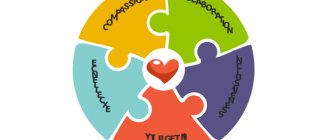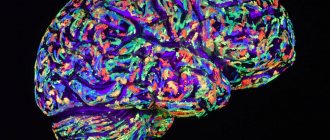Concept and structure
Self-concept is a system of psychological attitudes of an individual that relate to himself. It is formed and develops as one grows up and develops as an individual in society.
The processes of self-knowledge are influenced by many factors. Some of them are changed by a person himself, others do not depend on him.
Considering the structure of the self-concept, psychologists distinguish three components - cognitive, evaluative, and behavioral. Each of them covers different areas of self-esteem.
Cognitive
The cognitive component of the self-concept is a set of beliefs that can be true or deceptive.
Looking at beliefs in more detail, we can say that they have different significance. For example, a person considers himself brave, pays special attention to this, but at the same time does not think about his strength at all. The hierarchy of beliefs itself is not constant.
It can change with the stages of growing up, the influence of society, and social status.
Estimated
Each person constantly evaluates his characteristics. Estimates are formed under the influence of several factors:
- determining the effectiveness of one’s own activities;
- comparison of current social status;
- comparison of the idea of the ideal self.
Behavioral
The behavioral component of the self-concept is an objective opinion about oneself. A person cannot deny his behavior, words, actions, mistakes.
The impact of “I-concept” on a person’s life
In the life of each of us, the “I-concept”, by and large, has a triple meaning.
First of all, the “I-concept” ensures the internal consistency of the personality and relative behavioral stability. In the case when the new experience that a person receives does not diverge from his vision of himself, it is easily accepted by the “I-concept”. But if this experience is not consistent with the existing image and contradicts it, psychological defense mechanisms are activated, helping the person either somehow explain the negative experience, or simply reject it. Thanks to this, the “I-concept” remains balanced, even if real experience puts it at risk. According to the idea of Robert Burns, this desire of the individual to protect himself and avoid destructive influences can be called one of the foundations of normal behavior.
The second function of the “I-concept” can be called determining the nature of a person’s understanding of the experience he receives. Self-vision is a specific internal filter that determines the characteristics of an individual’s perception of any event and any situation. When events and situations pass through this filter, they are reinterpreted and given meanings that correspond to the self-concept.
And finally, the third on this list is that the “Self-concept” serves as the basis of a person’s expectations, in other words, his ideas about what should happen. People who are confident in their importance always expect that others will treat them accordingly, and those who doubt their worth tend to believe that no one needs them and no one likes them and, as a result, try to limit them as much as possible. your social contacts.
Hence the conclusion that the development of each person’s personality, as well as his activities and behavior, are always determined by the influence of the “I-concept”.
FINALLY: As you may have noticed, the topic of “Self-concept” is closely related to the process of self-knowledge, which means that if a person understands the characteristics of his personality and is aware of his own “Self-concept”, he can function in the world, interact with others, achieve success and development will become much easier and even more interesting for him. So we suggest that you do not put off working on yourself “on the back burner” and start getting to know yourself now (or at least in the near future) - especially for you, we have created a very interesting and effective course on self-knowledge, which can perhaps reveal to you almost all facets of your “I-concept”. You will find the course here.
We wish you success and productive self-knowledge!
We also recommend reading:
- Storytelling
- Theory of knowledge
- Vygotsky's concepts: contemporary relevance and actual modernity
- Lean concept. Lean
- The influence of social roles on personality development
- Ideas of Carl Gustav Jung
- Business Ethics: The Triple Criterion Concept
- Six Sigma
- Eric Berne "People Who Play Games" - summary
- Personality criteria
- Linguistic concept of Ferdinand de Saussure
Key words:1Psychoregulation
Formation mechanism
The mechanisms for the formation of self-psychology were proposed by I. S. Kon:
- Social comparison. When a system of criteria for self-esteem is formed, people begin to compare themselves with others. This process is called social comparison.
- Mirror reflection. A person forms an idea of himself based on the reaction to himself from others. From birth, an individual has no criteria for evaluating himself. She borrows them from other people and forms her own system.
- Self-verification, self-presentation. When a person has formed the initial image of his Self, he conducts a superficial check of the compiled image. To do this, he considers other people's assessments of himself.
- Hierarchization. The core of the self-concept consists of those qualities, properties, elements that are most important for the individual.
- Self-attribution. When a person forms an idea of himself, he receives information by observing his behavior, analyzing feelings, and studying the circumstances that influence behavior.
- Meaningful integration.
If you study the plane of the self-concept, you can identify a number of levels of its formation. They are relevant if all the content components of the structure interact. Levels of formation:
- aharmonious;
- disharmonious;
- mixed;
- optimal;
- harmonious.
As a person grows up, self-images become multi-component and differentiated. The first prerequisites for the formation of the self-concept appear already in infants. The child learns to divide sensations into his own, which manifest themselves from his personal activity, and external ones, which do not depend on him.
A little scientific background
In principle, the three previous paragraphs are more than enough to understand the main idea. If you do not want to delve into the psychological subtleties, just skip this block and continue reading from the next subheading.
In your subconscious there is your own image (it is also called self-esteem, self-perception, etc.). Your brain is a computing system that transfers your image into the world around you using tracing paper. Moreover, this happens both explicitly - your decisions, actions, etc., and implicitly - in the form of hidden processes that you do not control (emotions, metabolic processes, etc.).
Every time your image changes, you change too. Moreover, this law operates only in the forward direction, i.e. You cannot change if your inner image remains the same.
History of the study and researchers
Even ancient scientists tried to understand how a person imagines himself, evaluates his actions, and what factors he pays attention to. Numerous attempts to find answers to these questions have not yielded significant results.
The independent concept of self-concept began to take shape in the 19th century. Then scientists began to debate about the dual nature of man. The first scientist to contribute to the development of the self-concept was William James. The psychologist daily observed his actions, feelings, experiences, described changes, and asked others about himself.
Gradually, the relevance of the issue faded, but by 1950 the excitement around the self-concept flared up again. Abraham Maslow and Carl Rogers studied the position of one's own self as part of the process of personality formation.
30 years later, Soviet researchers became interested in the concept. They made a significant contribution to the development of this area.
There are many more examples
Self-concept can also be called self-positioning. How you position yourself is how everything will be in reality. I was lucky in this regard. When I started writing this blog, I didn’t know a lot. Yes, my brother and I had our own small store, and we often had to write texts and sell: products, ideas, collaborations, etc., but I was a layman when it came to copywriting. This is to be honest.
But I initially positioned my blog as a professional resource, and presented myself as a professional in my field. This, in fact, was my self-concept (which I knew nothing about at that time). The result was not long in coming: my brain itself made me the way I saw myself. Now many people consider me an expert, although in fact this is just the result of an inner vision and corresponding behavior. No more, no less.
Factors of influence
The formation and development of self-concept is influenced by:
- adequate expression of self-awareness;
- clarity of consciousness;
- presence of a threat (there should not be one);
- personal adequacy.
The description of oneself from the outside depends on the influence of external stimuli.
There are three types of self-esteem - low, average, high. The formation of low self-esteem is influenced by:
- constant demands for obedience;
- indifference on the part of relatives;
- conflicts in the family;
- remarriage, parental divorce.
Average self-esteem develops if:
- Parents accept the child for who he is and tolerate his behavior.
- Close relatives and friends treat the child patronizingly.
- Children's actions cause anxiety and worry in parents.
High self-esteem develops in children who:
- Receive care and attention.
- They are brought up in a family with clear norms and rules.
- They see the solidarity and unity of parents.
- They feel an atmosphere of mutual trust.
- Maintain good relationships with both parents.
- Understand the importance of actions that lead to achieving positive social status in the future.
In childhood, the most influential factors in the formation of the self-concept are the relationships between parents and the atmosphere in the family. Self-esteem also depends on maternal deprivation, the order in which children are born, the social status of the family, and relationships with peers.
Components of self-concept
Many people define self-concept as self-awareness and define the two concepts as synonyms.
Indeed, self-concept and self-consciousness can be called terms close to each other, but in some cases this concept is not equated with self-consciousness, but, on the contrary, is called the final product or the result of its processes.
William James identified several important components of the “I” in the self-concept:
- material (that with which a person associates and identifies himself. For example, his loved ones, housing, property, etc.);
- spiritual (internal attitudes of a person of a moral, religious and political nature);
- physical (a person’s own body, his primary needs);
- social (a person plays his own social role and receives a certain recognition in society by other people);
Self-concept and self-awareness are similar, but also different. - real (a person’s idea of himself in the present tense);
- fantastic (a person’s ideas about what he would like to be given certain opportunities);
- dynamic (a person’s intention to become what he wants);
- ideal (a person’s idea of what he could become in relation to moral standards).
One of the most important functions of the self-concept is to ensure internal consistency and stability of individual behavior. The formation of this concept occurs during a person’s life experience.
This is especially true for children's relationships with their parents. The self-concept takes on an active role quite early. It influences a person’s life goals and assessment of their achievements, his expectations and system of forecasts for the future.
Issues
Psychiatrists identify two problems of the self-concept - the development of self-control mechanisms, the relationship between the conscious and the unconscious. In recent years, the problem of computer addiction has emerged, which prevents schoolchildren and students from self-realization and developing skills.
Self-concept is a set of beliefs and characteristics on the basis of which a person views himself from the outside. The formation of self-esteem is influenced by various factors. Some of them depend on the individual, others do not.
I am the image
Throughout his life, a person thinks little about the unity and details of his “I”, which, however, does not prevent him from using all his might (mostly subconscious and unconscious processes) to protect the integrity and safety of this formation.
In attempts to clarify and somehow structure the complex concept of “I,” a number of psychologists have identified a number of formations in it: “I”-image, “I”-concept, “ego.” In scientific psychology, this was first done by W. James, dividing the “I” into the “I”-cognitive and the “I”-cognized. There are other concepts that are largely similar to each other: “I”-deep, “I”-real and “I”-ideal, “I”-higher and “I”-lower, “I”-inner and “I” - external, “I” - potential and “I” - actual. The list of terms itself suggests that there is no common understanding of this issue.
The way an individual sees and imagines himself, his behavior and his internal experiences can be united by the concept of “I”-image” or “I”-concept.” The “I” image is an attempt to understand oneself as if from the outside, and this is what distinguishes this concept from the holistic and much more monolithic concept of “I.” It must be understood that by highlighting the concept of “I”-image, the psychologist receives only a distant idea of the true formations of the psyche reflected in the concept of “I”.
Read: Social instances of the psyche
Normally, the “I” image represents a holistic formation. At the same time, having quite clear characteristics, the “I”-image is not something complete and unchanging, since at different periods of one’s life, moreover, to be precise, at every moment, an individual’s idea of himself changes. In other words, the “I” image is closely tied to the time parameter and time dynamics; outside the time frame, the characteristic of the “I” image is relative. In scientific studies involving a group of people, the “I” image actually represents a certain average type. This type looks like a statistically significant formation, subject to change in one direction or another.
In translated literature, the term “I”-concept is often used, which is similar to “I”-image.” This concept has caught on, although it does not seem to be the most successful. After all, understanding a concept initially presupposes a somewhat coherent and strict system of views, and self-esteem is a rather changeable thing.
In the “I”-image, we can distinguish the elements of the “real I” and the “ideal I”. By “I”-real we mean the idea of oneself as a formed, accomplished individual; “I”-ideal is what the individual strives for, how he would like to see himself ideally. The “I” image acts as an established system of views in relation to oneself, an attitude (see below “Personal Attitude”), with all the ensuing positive and negative consequences. In the context of the “I”-image under consideration, the model of the “I”-actual and the “I”-potential (A. Podvodny) seems more successful (and logical). “I”-actual is how the individual imagines himself “here and now”; “I”-potential is who and what, in the individual’s opinion, he could become. When comparing the mentioned models, the difference between the “ideal self” and the “potential self” is clearly visible: in the first case there is a shade of desires (for example, the desire to be happy, rich and live for many years), and in the second case there is a shade of inner self-confidence . Desires (the “ideal self”) can be quite divorced from reality, since they are largely formed under the influence of social values, social norms, morals and ethics. Inner self-confidence (“potential self”) reflects the initial rigid program for the development of a given personality embedded in the unconscious. However, in practice, these differences are leveled out, since the definition of such concepts must be based on tests, and, alas, there are no clear tests containing delimiting criteria.
Read: Social groups and social roles
According to external signs, the concepts of “I”-actual (“I”-real) and “ego” are in many ways similar; indeed, self-images always reflect the ego in some way. The criterion for difference is the fact of control by the ego. In form, the most suitable concept for the “ego” is the “lower self” - that which forces one to plunge into the world of sensual (material) pleasures, forgetting about inner knowledge, and turns away from the investigations of oneself.
You might be interested in:
- The concept of personality in psychology
- The concept of “I” in psychology
- "I" - deep
- What is consciousness
- What is "Ego" (Self)
- Perception
Subscribe to our channels in
Yandex Zen and Telegram











